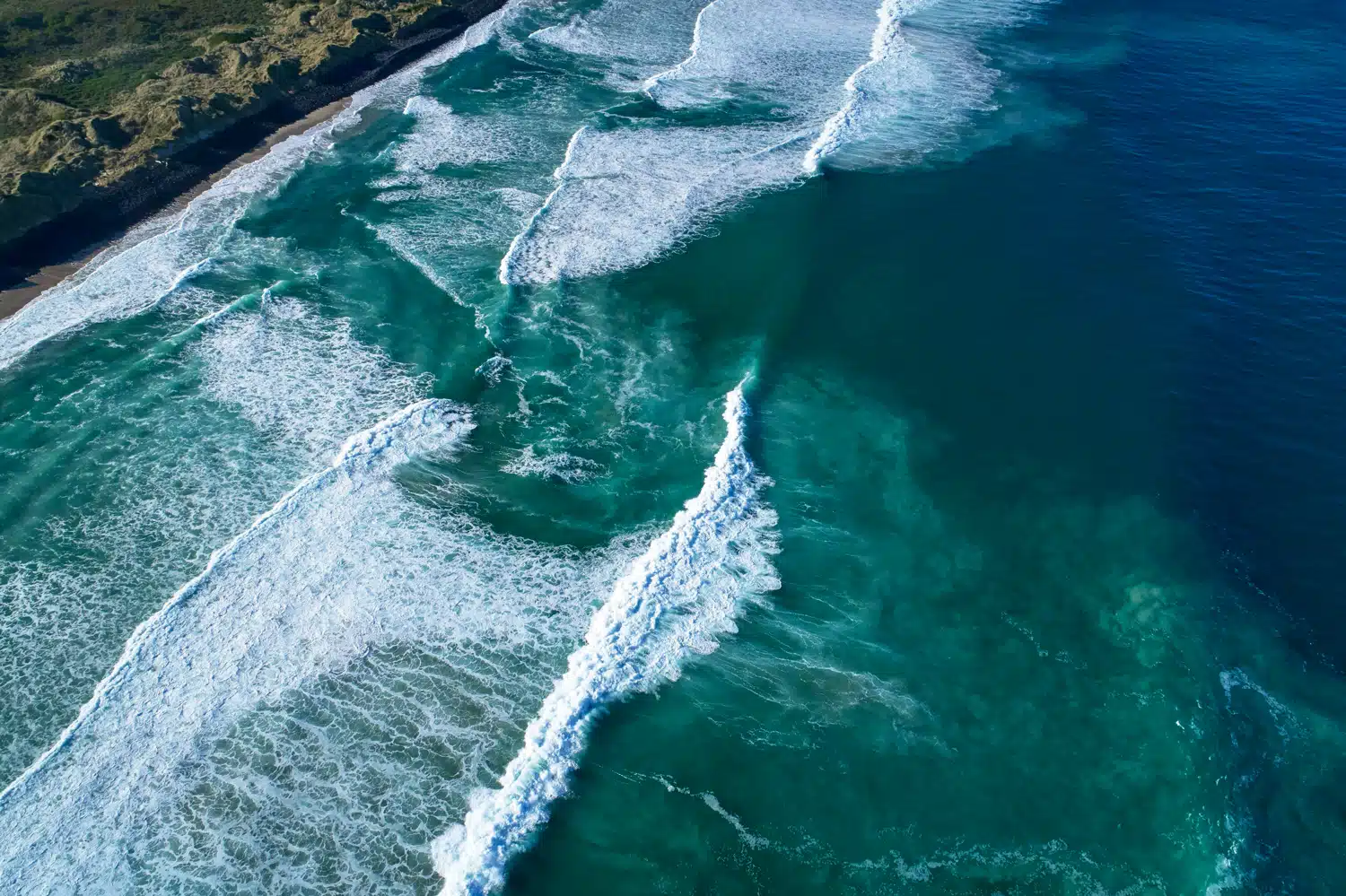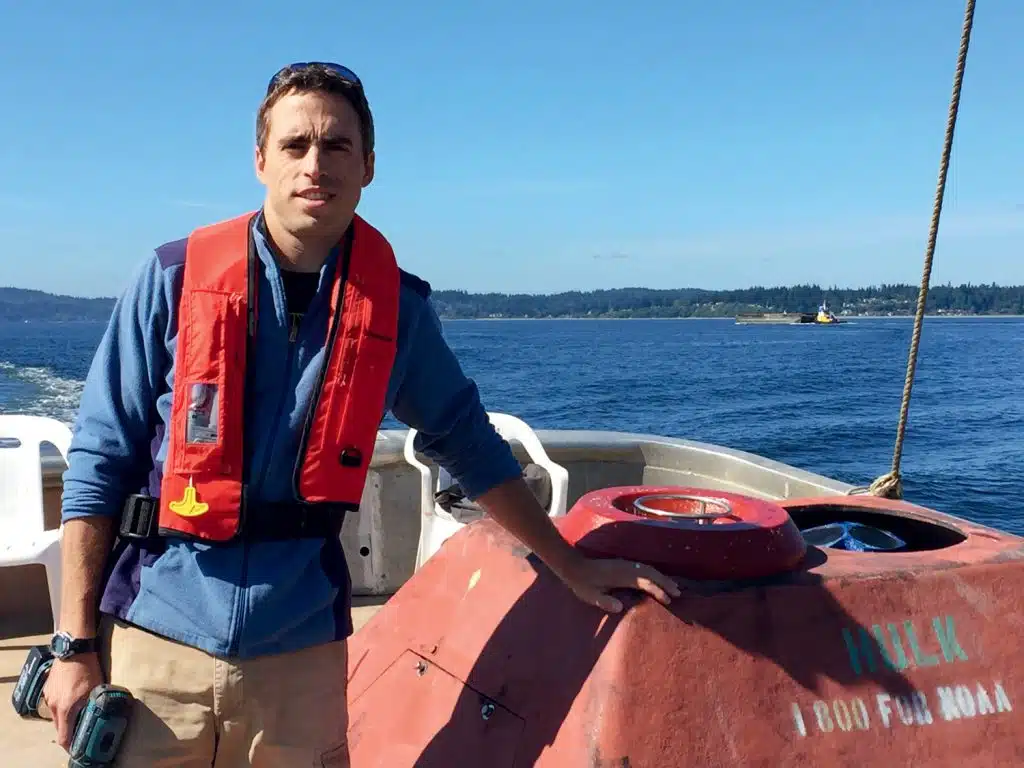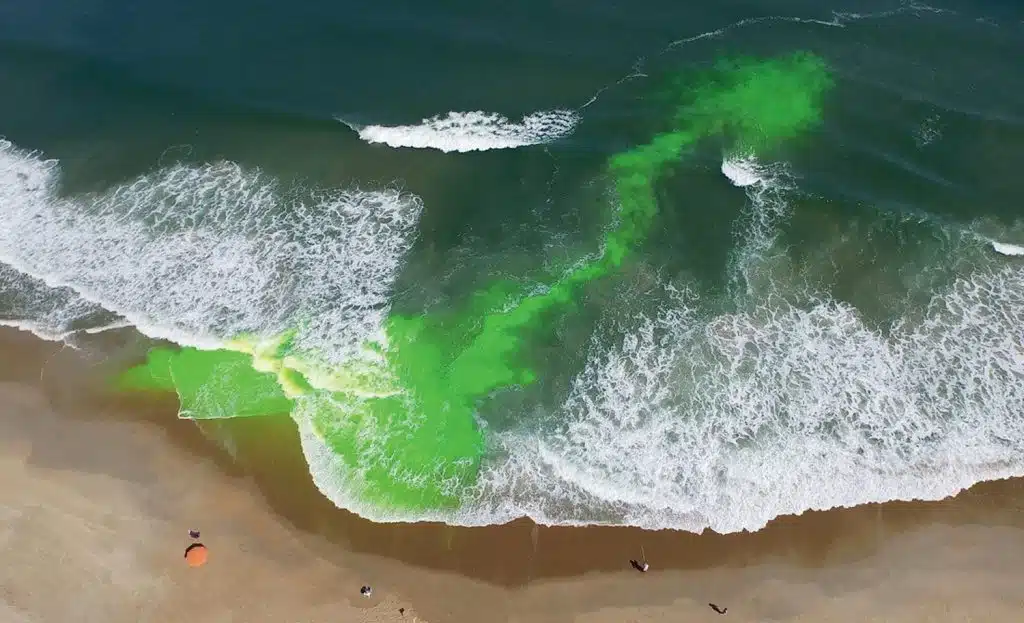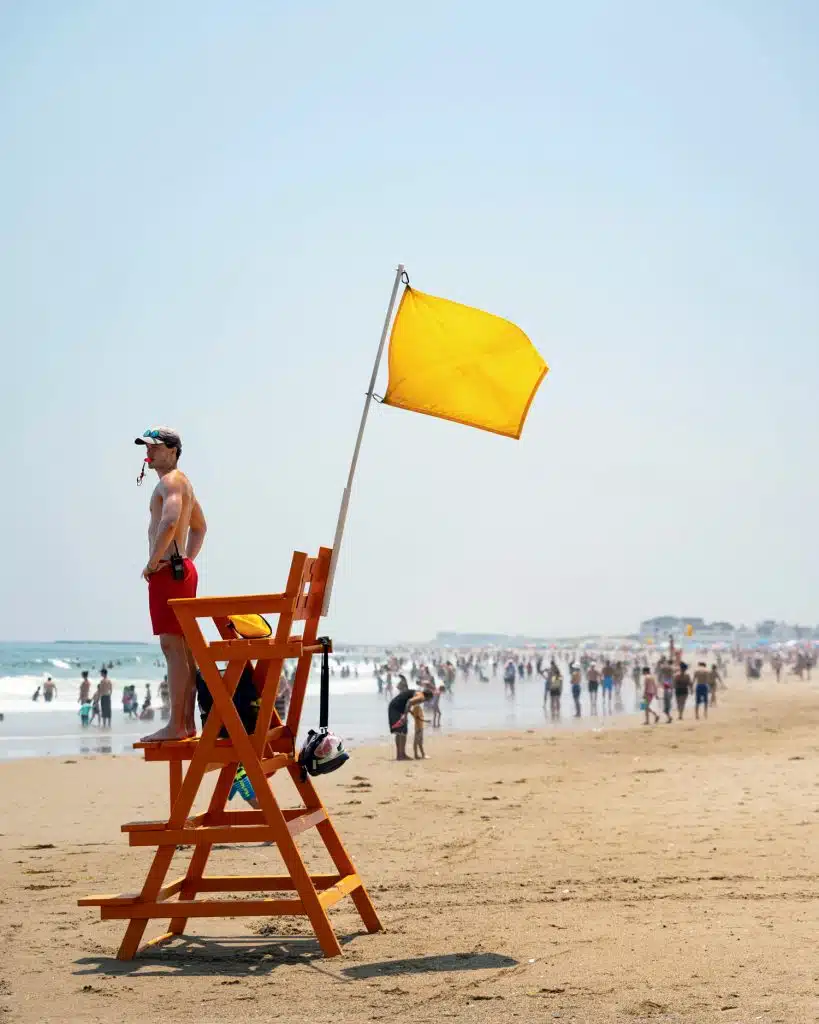Swept Away | The Hidden Dangers of Rip Currents
Some stories can save lives. This is one of them. Rip currents cause an annual average of 71 fatalities in the U.S. alone. Learn how to spot a rip current and what to do if you’re caught in one.

Coffee By Design | Portland, Maine
Photo Credit : Katherine KeenanBy Michael Wejchert
Ella Bezanson didn’t hear the cries for help until she turned to leave the beach.
Record rainfall drenched New England in the summer of 2023, but July 22, a Saturday, was about as perfect at New Hampshire’s Hampton Beach as anyone could ask for: 75 degrees with just a hint of cloud. The iconic seashore was packed full of swimmers queuing up for fried dough and applying sunscreen and racing across the thin strip of sand to frolic in the waves, relishing the rare, welcome sun as it warmed the salty air.
On a busy summer day, Hampton Beach can get more than 100,000 visitors. But by 8 that evening, the daytime crowds had dispersed, and although many swimmers remained, the lifeguards had all gone home at closing time, 5:30 p.m. Bezanson, a 19-year-old sophomore nursing student at the University of Southern Maine, vacationed at Hampton Beach every year with her family. This evening, her first day at the beach, she was walking along the boardwalk with her father and her two small cousins, who were both excited to try out the remote-control cars her dad had just given them.
At first, she didn’t think much of the yelling. She assumed they were overexcited yelps from happy beachgoers.
It’s Hampton Beach. People scream all the time, Bezanson thought. But as she turned on the boardwalk to head back to the family’s rental property, she noticed a tense cluster of onlookers watching a pair of swimmers from the northern part of the beach, just across from Ashworth by the Sea, a historic boardwalk hotel. “I just saw people flailing their arms and going up and down in the water,” Bezanson recalls. “They were really far out.” And she realized these weren’t happy cries.

Photo Credit : ©Deb Cram/Seacoastonline/USA Today Network
A high school softball all-star and lifelong athlete, Bezanson powered her compact frame toward the water’s edge in a dead sprint. As she got closer, the panic became palpable.
“They can’t swim! They can’t swim!” onlookers screamed. The two bathers had been caught in a rip current, a strip of ocean water tearing back out to sea, and they were bobbing farther and farther away from shore.
Nearing the low-tide mark on the beach, Bezanson snatched a boogie board from a woman who had been standing and staring at the two people far out in the water. The teenager surged into the water, mounted the board, and began paddling. After five minutes, she found herself a good 200 yards offshore, caught in the same rip current that had carried the two swimmers. Kicking closer to the victims, she could now make them out more distinctly: a woman trying to execute a backstroke and a man who “was just flailing, up and down. All I could see was the top of his head.”
“Call 911! Call 911!” Bezanson screamed toward shore. The woman floated within her reach, trying to stay on her back. But the man kept drifting away. He did not appear to know how to swim.
Bezanson realized she would be able to pick up only one person with the little boogie board. In an instant, she made a wrenching decision. She would try to save the one with the greater likelihood of survival. She paddled toward the woman and offered the boogie board. The woman latched on.
“Kick as hard as you can,” Bezanson ordered, and together they began working their way back to shore. Soon, both women were exhausted. Bezanson’s father, meanwhile, had called 911. At around 8:30, ambulances and fire trucks screamed down the one-way road next to the boardwalk as the summer sun sank lower in the sky. A team of rescuers—Hampton firefighters and off-duty lifeguards—streamed into the surf. Paddling toward them, her muscles straining with the effort, Bezanson admonished the woman to kick harder.
Behind them, the drowning man receded in the distance, his head visible only occasionally, as the Atlantic swept him away.
* * * * *
Shark attacks, the marquee fear of most New England beachgoers, kill one swimmer in the U.S. every two years, on average. Yet rip currents cause an annual average of 71 fatalities in this country alone. Beachgoers looking to monitor sharks slicing through the Atlantic have two engaging apps to choose from; meanwhile, common sense and storm warnings keep swimmers away on days when the ocean roils with dangerous swells. But despite the efforts of several information campaigns, rip currents have failed to capture the public’s imagination the way that sharks or rogue waves do. No one has made a disaster movie about rip currents. Even as Bezanson paddled out into the middle of one, her fears weren’t centered on rip currents: “I thought, I’m going to get eaten by a shark right now,” she told me last fall.
The risk of a rip is highest when it is amplified by foibles in human nature, explains Greg Dusek, a senior scientist at the National Oceanographic and Atmospheric Administration (NOAA). Compared with other hazards, a rip current seems benign, and that makes it dangerous. At the beach, rips are the hazard that swimmers least expect but the one they are most likely to encounter.

Photo Credit : Courtesy of Greg Dusek
A rip current is a flow of water directed seaward that most often occurs in the surf zone, where waves break in the shallow part of the coast. As these waves are pushed toward shore, seawater tries to find the quickest path back to the ocean, flowing into troughs that have formed between sandbars. These deep channels act like the drain of a tub: As water rushes into these natural drains, it is pushed out anywhere from a few hundred feet to a quarter mile offshore, Dusek says. The water in these currents, which are typically ten to 100 yards wide, travels back out to sea at speeds of up to 5 mph. This doesn’t seem fast—until Dusek points out that swimmers like Michael Phelps hit this speed while gunning for new world records. Even an Olympian, in other words, would struggle to return to shore.
Compounding this danger, the channels where rips appear often seem like the most welcome place to swim because they’re the only place on a beach where waves aren’t breaking. “[Safety] is mostly about being aware of them and being able to spot them,” says Drude Christensen, a surf zone expert and a postdoc fellow at Woods Hole Oceanographic Institution (WHOI) in Massachusetts. “People go to a beach and see an area with nice calm conditions and no strong waves breaking. That’s where they go. And that’s exactly where the rip is.”
* * * * *
What is perhaps the most famous rip accident happened in Australia, on Sydney’s Bondi Beach, in 1938. On a sweltering-hot Sunday in February, tourists and locals flocked to the waterfront. Heavy swells slammed the coast all weekend. On that Saturday, February 5, lifeguards had rescued 74 people in a single hour.
But on Sunday, the beach remained open. The morning was placid. A sandbar seduced hundreds of bathers into wading farther out than they’d usually dare. In the afternoon, though, a set of large waves slammed into the concave beach, knocking bathers off their feet. The swells happened in rapid succession, meaning seawater piled into the beach with nowhere to go. As it rushed back out, it created a flash rip current, carrying more than 200 people out into deep water.
A chaotic rescue effort soon involved both lifeguards and bystanders. Responders remembered punching their way through panicked bathers to save victims. In the end, 35 people pulled from the water lay unconscious on the beach, where resuscitation attempts began en masse.
“I have never seen…such a magnificent achievement as that of your lifesavers,” an American doctor who happened to be at Bondi told the lifeguards. In the end, just five people died, a shockingly low number that speaks to the rescuers’ quick actions. One of the five fatalities was a German-born chef who drowned saving a little girl.
“Black Sunday” is now seen in Australia as an inflection point in modern lifeguarding, but it’s unclear whether any of its lessons have soaked in on other continents. Scrolling through America’s rip current headlines nearly 90 years later, it’s hard to ignore the crop of tragedies.
In September 2023, a 44-year-old father of four named Gary Simard swam out to save his son at Massachusetts’s Salisbury Beach, just south of Hampton Beach. When his son returned safely to shore in the company of two bystanders who had rushed to help, there was no sign of Simard. First responders eventually pulled Simard from the water, performed CPR, and transported him to a nearby hospital, where he was pronounced dead. Last year’s rip statistics are riddled with tragic cases like Simard’s: In June, New York firefighter Mark Batista drowned off the New Jersey shore after he tried to save his teenage daughter from a rip current; that same month saw multiple rip current tragedies in Alabama and Florida. In early July, a 42-year-old father named Rajesh Potti died saving his young son in Florida.
* * * * *
In the dynamic surf zone, rip currents rarely remain in one place. Their changing nature—like avalanches occurring on different aspects of mountain slopes—makes them hard for scientists to observe, even at crowded beaches like Hampton. It also makes them hard for recreational swimmers to spot. In a 2022 article in The Atlantic, Chloe Williams notes that the most important predictor of how deadly a rip may be “is the number of people in and around it.”
“The sea floor is constantly changing, so it might not look the same the next day,” says Melissa Moulton, a coastal physical oceanographer and a leading expert on rip currents. She grew up going to the beach in Massachusetts, where she was fascinated by the tides and currents she observed there. While rips might be dangerous for people, Moulton stresses, they’re vital for healthy shorelines, playing an essential role in the life cycle of the ocean as they move organisms in larval stages out to sea and recirculate them in the shallows in turn.

Photo Credit : Courtesy of NOAA
In tackling the problem of studying rips, Moulton has had to get creative. In 2012, she decided to build her own rip current with the help of the U.S. Army Corps of Engineers (USACE) field research facility in Duck, North Carolina. Using a 73-foot-long military landing craft, WHOI scientists and a USACE team dug the boat’s old propellers into the sand, creating a channel as they slowly chugged out to sea. It took three attempts, but the team finally dredged a channel in a spot where breaking waves created a real-life rip. After the landing craft was moored safely offshore, Moulton and her colleagues donned scuba gear (she compares the difficulties of working in the surf zone to taking measurements in a washing machine) and placed specialized equipment in the channel to record observations of wave behavior, the changing sea floor, and the speed of the rip current. Even a small channel surrounded by small waves, the kind a swimmer might find at a public beach on a nice day, was enough to create a powerful rip current.
Surf zone scientists haven’t stopped with churning up the ocean floor. Moulton has used low-flying spotter planes, a massive artificial wave basin at Oregon State University, and computer models to better understand and predict rips. This work has helped amass data that more accurately illustrate the conditions in which rips are likely to occur. Yet none of this information saves lives unless it’s successfully relayed to the public. That’s where Greg Dusek, NOAA, and the National Weather Service come in.
“[Outreach has] really been a focus for us ever since I’ve been working on this,” Dusek tells me. “We could create an awesome predictive model, just like with a lot of weather and climate and ocean phenomena; we could tell you exactly where there’s going to be a rip current—and we would still get people drowning in those rips if we don’t communicate well. So, the prediction piece is helpful, but how do you get people to utilize that information to make smart decisions about where and when they’re swimming?”
On paper, escaping a rip current is simple: Don’t panic. Swim parallel to the shoreline, out of the channel and into breaking waves that push toward the beach. Stay afloat; eventually a rip might even return you to shore. But no technique works for every scenario or rip current. And as Dusek explains, panic strikes even the most experienced swimmers in the chaotic environment of fast-moving water.
In 2020, Dusek and a colleague created a virtual-reality simulation of what it’s like to be caught in a rip current and found that even seasoned swimmers who knew they were playing a video game—not swimming for their lives—had a hard time remembering to exit the rip and return with breaking waves. “Even if they knew what to do, they would struggle with actually doing it and start freaking out,” Dusek recalls.
Many of the variables of rip current fatalities fall into the human side of the equation. A large percentage of rip current drownings are bystanders who rush in to help. Ella Bezanson was right to grab flotation like a boogie board before charging into the water, but many would-be rescuers fail to take this step and quickly lose energy in the water.
Lifeguards are on the front lines of this dangerous intersection between people and rip currents. Swimmers have a one-in-18-million chance of drowning at a beach with a lifeguard on duty. “It’s really hard to drown with a lifeguard at the beach,” Dusek says. “And from a rip current science standpoint, lifeguards have been pivotal as well.” They provide on-the-ground observational data that help forecasting models be as accurate as possible. If Dusek, Moulton, and others are working as hard as they can to prevent people from getting stuck in rip currents, lifeguards are working equally hard to save them when they do.
* * * * *
It’s a Tuesday when I visit Hampton Beach, and even though it’s October, sunburnt retirees in board shorts stroll down the boardwalk. Overladen bathers struggle to carry beach chairs and tote bags down to the water’s edge. Some shops, like the Sea Ketch Restaurant, remain open for business, while others are shuttered for the season. Patrick Murphy, chief of the New Hampshire State Beach Patrol, stands just past the lifeguard station in the center of the beach’s mile-long strip. Murphy’s deep tan and ropy, muscular frame—formed by the job he has held for the past 20 years—betray his profession, as does the badge on the waistband of his board shorts. He walks me down to the beach, where two younger lifeguards stand sentinel, their Ray-Ban sunglasses shading eyes that monitor swimmers venturing into the unseasonably warm fall water.
When Murphy started as an 18-year-old, his position, like most lifeguarding roles, was seasonal, and for years he worked as a teacher at summer’s end. The beach’s more troublesome visitors prepared Murphy for working with at-risk youth, a job he held until he accepted the chief lifeguard role several years ago. Being Hampton’s chief lifeguard is “the best job you could possibly have,” he tells me. Now, Murphy’s winters are spent hiring seasonal staff.
The qualifications are rigorous, and summer mornings are spent training. The drills that Murphy picks are often informed by real-life rescues. Random incidents—like the one in July 2023 when a plane crashed in the surf zone, and lifeguards paddled out to rescue the pilot and recover the aircraft before it leaked gas into the ocean—turn into teachable moments and training scenarios. Murphy and his lifeguards train until saving swimmers becomes routine, because in the summer it is.
“You can’t be tired; even when you are, someone needs your help. If you go out, you might have to go right back out,” he says.
Every once in a while, the waves, the weather, and the people collide in what Moulton ironically calls “the sweet spot,” as they did on Labor Day weekend in 2023, when Murphy’s lifeguards participated in 91 rescues over the course of four days, half of them related to rip currents.
Red flags were flown at Hampton Beach that weekend, meaning high surf and strong currents; bathers were restricted to going in just to their knees or waists. Regardless of these precautions, lifeguards participated in 32 rescues on Saturday. On Sunday there were 52. Murphy’s crew was shorthanded; many seasonals had left to return to college or high school. This meant that while the main beach was still covered, many of the outlying beaches were not. All weekend long, lifeguards returned to the water, watching wave and weather patterns, hoping to use wind direction and waves to work with—not against—the ocean, as they floated out to victims and returned them safely to shore.

Photo Credit : Jack Loosmann
As we stare at the water, Murphy points toward a vertical strip of surf that, to my untrained eye, looks like the most attractive place to swim. Today, the waves are breaking at around two to four feet, and beachgoers frolic in the water. “When you drop [waves] down to that range,” Murphy explains, “it’s more inviting. And the less water that comes in, the rip currents actually pull more. And that’s what we have today.” Most swimmers won’t venture out when waves are breaking around six feet.
Days like today loom as the fundamental challenge in Greg Dusek’s work at NOAA. Campaigns like “Break the Grip of the Rip,” a joint venture by NOAA and the United States Lifesaving Association, are aimed at raising public awareness. Meanwhile, the National Weather Service offers forecasts—based on data collected by scientists like Moulton and Christensen—that provide a color-coded risk assessment for what to expect at the beach on any given day. These are both attempts at getting people to avoid rip currents altogether. On my way to interview Murphy, I stroll past a huge “Break the Grip of the Rip” sign on the boardwalk. It’s hard to miss. People still do.
* * * * *
The woman that Ella Bezanson picked up on her boogie board was named Edzana Fernandes. She had gone to the beach with her coworkers that day, including Edmilson Gomes, the 27-year-old man who was swept away by the rip current. Gomes’s social media profiles give a partial picture of a fit, trim young man who valued his family above everything else: Posting about how much he missed his father, who had just died that spring. Posing with his brother wearing a “Black Lives Matter” T-shirt in the summer of 2020. Unwrapping Christmas presents with his siblings.
“Where’s the other swimmer?” Bezanson remembers a rescuer asking as he waded past her and Fernandes on their 15-minute paddle back to shore. That was Murphy, who had gotten the call at 8:26 p.m., nearly three hours after he’d gone home for the day, and headed back to the beach.
When Bezanson and Fernandes finally reached shore, they collapsed on the sand, utterly done in. Fernandes’s eyes were bloodshot from the effort. Both women began crying, overcome by exhaustion and emotion. “It was just so traumatizing,” Bezanson told me.
Looking up, Bezanson saw four rescuers carrying Gomes back to the beach. He was completely limp. First responders performed CPR on Gomes before he was taken to a waiting ambulance and rushed to Portsmouth Regional Hospital. After three days, he moved his hands, according to an interview with Fernandes, who told a journalist that her coworker was “getting better.” But he remained in a coma. And on August 1,
10 days after the incident, Gomes passed away, one of 90 deaths—19 above average—that the National Weather Service attributed to rip currents in 2023.
Neither swimmers nor rip currents are going away anytime soon. As the climate warms, people are flocking to the beach in record numbers. It’s unclear how much ocean temperatures, rising seas, and other effects of climate change might affect the likelihood and risk of rip currents. “We don’t have really good quantitative long-term observations of rip currents. So it’s hard to know: Are they changing from where they were 10 or 20 years ago?” Dusek says. “There’s research that suggests we’ll see larger waves with climate change moving forward. And if we see larger waves, more frequent storms, then yes, we would expect to see increases in rip current activity.”
As scientists and lifeguards collaborate to make beaches safer, they are hopeful the number of deaths might diminish. Still, they face an uphill battle. It’s not just the ocean they’re struggling to control.
“The problem with rips is that it’s not just the rip current,” Dusek says with a rueful smile. “It’s people and the rip current.”




